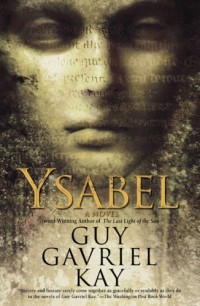 I had been eager to read Ysabel by Guy Gavriel Kay (Roc-Penguin, 2007; all quotations are taken from this text), which won the 2008 World Fantasy Award for Novels, and indeed to read any book by Kay, who’s been highly recommended to me, particularly for his historical fantasies. What I’ve decided to focus on in this post is what I learned from Ysabel and from Kay at the plot- and characterization-level, as well as Kay’s use of an archetype I had previously worked with in a short story, where two men vie for the same woman. Warning: Spoilers to follow.
I had been eager to read Ysabel by Guy Gavriel Kay (Roc-Penguin, 2007; all quotations are taken from this text), which won the 2008 World Fantasy Award for Novels, and indeed to read any book by Kay, who’s been highly recommended to me, particularly for his historical fantasies. What I’ve decided to focus on in this post is what I learned from Ysabel and from Kay at the plot- and characterization-level, as well as Kay’s use of an archetype I had previously worked with in a short story, where two men vie for the same woman. Warning: Spoilers to follow.
As I read Ysabel, I paid attention to how Kay built the plot of his novel in a way that didn’t feel forced or too “scripted” (that is, the characters didn’t appear to act out of blatant service to the plot). Kay works efficiently in the first chapter establishing his plot (as he also does with his characters, which I’ll discuss later), introducing the fifteen-year-old protagonist Ned, establishing the setting in Provence, meeting the “love” interest (Kate), and setting the main mystery in motion, all within 16 pages. Interestingly, he doesn’t end the first chapter with the disappearance of the mystery man (Phelan) from the cathedral, but rather with Ned’s discovery in a chamber underneath the floor: “And it was then, as he turned to go back, that the bright, narrow beam of Kate’s flashlight, playing along the corridor, illuminated a recessed space, a niche cut out in the stone wall, and Ned saw what was resting in it” (23). It’s not until the top of page 25, however, that Kay reveals to the reader that a skull is sitting in the niche; the half-page of text on page 24 sets up Ned’s reaction to the skull first before revealing it. I thought this delay was an interesting technique, contrary as it is to the expectation that the reveal would come immediately at the beginning of the next chapter rather than a page into it. The technique was interesting in terms of pacing, so if I wanted to quickly the skim the beginning of the next chapter to discover what Ned saw, I’d have to read a good chunk into that next chapter instead—which would probably propel me to keep reading the rest of that chapter. It’s an effective technique, and I compared it to J.K. Rowling’s pacing in the Harry Potter books, where she ends each chapter (or almost each one) with a little cliffhanger. It’s no wonder that people would stay up reading all night!
Kay continues with his efficient plot-building by bringing Phelan back into the story, first by encounters with Ned and also by a point of view shift to Phelan a couple of times. Interestingly, Kay puts Phelan’s and later Ysabel’s sections in present tense (the rest of the novel is told in past tense). Given that Phelan, Ysabel, and Cadell are a constantly reincarnated love triangle, I liked the use of the present tense for their sections, indicating as it does a kind of timelessness.
The mystery—what’s going on with Phelan and later Cadell, after Ned meets him—is solved at the end of Part One, which ends on page 179, about halfway through the book (Phelan and Cadell are reincarnations of an ancient Greek and Celt, both of whom competed for and were loved by Ysabel, whose spirit—at certain times and through a particular sacrificial ritual—is brought back to inhabit/take over the body of a contemporary woman. Ned’s father’s assistant, Melanie, stumbles upon the ritual, trying to help Ned, and is transformed into Ysabel and sets a challenge for her suitors:
“Find me,” she said coldly, “and so keep me, if it matters so very much. Or wander off to make another carving. Stone instead of flesh, as you choose. But swear now, both of you. Three days. Find me. The loser is a sacrifice, for his failure.” (178)
The second half of the novel sets up the second mystery—who will find Ysabel first? Phelan, Cadell, or Ned and his friends & family, who hope to restore Melanie to herself? One thing I found a little distracting is the amount of recounting Kay incorporates into the novel—any time anything happens to Ned, he retells it to his father and friends; and when Ned’s mother arrives, the entire first half of the novel is retold to her, without much new information being presented to the reader. It was a little frustrating as a reader, actually, to have so much retold directly (a little more indirect summary would have been appreciated). I understand Kay is trying to keep all the details straight for the readers, but I wish he had done so in a less cumbersome way.
Oddly enough, I found Kay’s use of repetition particularly efficient in building Ned’s character; he uses the same technique with other characters, although those characterizations tend to be a little less rounded and more focused on one dominant trait (Kate’s tendency towards geekiness, Melanie’s attention to detail and predilection for green, his father’s mustache, his mother’s organization and logic, etc.). All of the characters felt fully developed, even though they aren’t as distinct as Ned.
Kay first establishes Ned as a fifteen-year-old through teenage attitudes, such as the first line of chapter one, “Ned wasn’t impressed” (7). Further down that page, “He was supposed to feel cool about being by himself in here.” On the next page, his teenage attitude comes out here: “Ned figured it was just as easy to stick around the others this morning; he was still feeling a bit disoriented and far from home. Didn’t have to tell anyone that, though” (8). References to Ned’s e-mailing his friends at home pepper the early chapters (and continue throughout the novel). When Ned meets Kate, another visiting fifteen-year-old, in the first chapter, Kay uses a mix of dialogue and interior monologue to reveal more of Ned’s character—the teasing/flirting between the two of them immediately, even when he tries to be a little more aggressive than he normally is:
Her jaw actually dropped [at the revelation that famous photographer Edward Marriner is Ned’s father]. Ned felt the familiar mix of pleasure and embarrassment. “You messing with me?” she gasped. “Mountains and Gods? I know that book. We own that book.”
“Well, cool. What will it get me?”
She gave him a suddenly shy look. Ned wasn’t sure why he’d spoken that way. It wasn’t really him. Ken and Barry talked that way to girls, but he didn’t, usually. He cleared his throat. (14)
This moment effectively captures how Ned, at 15, is trying to figure out how to negotiate the waters of adult flirtation, and indeed the waters of adulthood, period. But the line about Ken and Barry reveals Ned’s lack of total comfort yet. When Ned and Kate meet Phelan and he threatens them, saying, “I have killed children before,” Ned initial thought is “Children? They weren’t kids” (16)—he bristles first at the idea that he’s being referred to as a child rather than at the threat. Despite the threat, Ned keeps up a banter with Phelan, holding his own. After Phelan leaves, Ned decides to visit the underground chamber from which Phelan had emerged:
He still wasn’t quite sure what he was doing, or why. He looked at that faded bull on the wall. It sure didn’t look like any church art he knew. This place was really old. He shivered. And perhaps because of that, because he felt scared, he walked quickly back, knelt again by the grate, put both hands on it, and pulled. (21)
and later “And then, before he had time to think about it and get really frightened, he put his feet over the edge of the pit, turned so he was facing the side, and lowered himself” (22). Ned’s in the process of becoming a man, and confronting fear—not being ruled by it—is one step, and we frequently see Ned being brave when he’d rather not. Throughout the rest of the novel, Ned marvels at the fact that the adults around him respond to his authority in the matter of the mystery (granted, it’s because of his burgeoning second sight, but the metaphor remains intact). Another important element of Ned’s characterization, his running, is introduced in the first chapter via mention of his running shoes, and his running is important to the plot at the end of the novel (repetition of scenes of his running and thinking about his track log helps solidify this element throughout the first part of the novel).
Overall, Kay builds both plot and characterization efficiently, using techniques I think I could follow. Studying Kay’s use of repetition was illuminating, in that I have a better understanding of how much repetition is helpful and how much is distracting to the reader.





